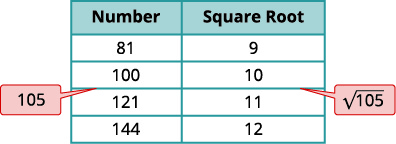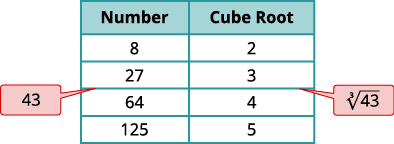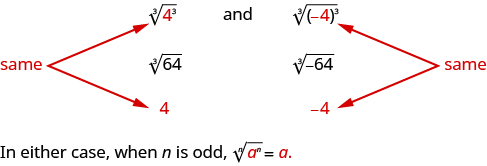
By the end of this section, you will be able to:
Before you get started, take this readiness quiz.
In Foundations, we briefly looked at square roots. Remember that when a real number n is multiplied by itself, we write
and read it ‘n squared’. This number is called the square of n, and n is called the square root. For example,
Square
Square Root
Notice (−13)2 = 169 also, so −13 is also a square root of 169. Therefore, both 13 and −13 are square roots of 169.
So, every positive number has two square roots—one positive and one negative. What if we only wanted the positive square root of a positive number? We use a radical sign, and write,
which denotes the positive square root of m. The positive square root is also called the principal square root.
We also use the radical sign for the square root of zero. Because
Notice that zero has only one square root.
We know that every positive number has two square roots and the radical sign indicates the positive one. We write
If we want to find the negative square root of a number, we place a negative in front of the radical sign. For example,
Simplify: ⓐ
ⓑ
ⓐ* * *
ⓑ* * *
Simplify: ⓐ
ⓑ
ⓐ
ⓑ 15
Simplify: ⓐ
ⓑ
ⓐ 10 ⓑ
Can we simplify
Is there a number whose square is
Any positive number squared is positive. Any negative number squared is positive. There is no real number equal to
The square root of a negative number is not a real number.
Simplify: ⓐ
ⓑ
ⓐ* * *
ⓑ* * *
Simplify: ⓐ
ⓑ
ⓐ not a real number ⓑ
Simplify: ⓐ
ⓑ
ⓐ
ⓑ not a real number
So far we have only talked about squares and square roots. Let’s now extend our work to include higher powers and higher roots.
Let’s review some vocabulary first.
The terms ‘squared’ and ‘cubed’ come from the formulas for area of a square and volume of a cube.
It will be helpful to have a table of the powers of the integers from −5 to 5. See [link].

Notice the signs in the table. All powers of positive numbers are positive, of course. But when we have a negative number, the even powers are positive and the odd powers are negative. We’ll copy the row with the powers of −2 to help you see this.
 We will now extend the square root definition to higher roots.
We will now extend the square root definition to higher roots.
Just like we use the word ‘cubed’ for b3, we use the term ‘cube root’ for
We can refer to [link] to help find higher roots.
Could we have an even root of a negative number? We know that the square root of a negative number is not a real number. The same is true for any even root. Even roots of negative numbers are not real numbers. Odd roots of negative numbers are real numbers.
When n is an even number and
then
is a real number.
then
is not a real number.
When n is an odd number,
is a real number for all values of a.
We will apply these properties in the next two examples.
Simplify: ⓐ
ⓑ
ⓒ
ⓐ* * *
ⓑ* * *
ⓒ* * *
Simplify: ⓐ
ⓑ
ⓒ
ⓐ 3 ⓑ 4 ⓒ 3
Simplify: ⓐ
ⓑ
ⓒ
ⓐ 10 ⓑ 2 ⓒ 3
In this example be alert for the negative signs as well as even and odd powers.
Simplify: ⓐ
ⓑ
ⓒ
ⓐ* * *
ⓑ* * *
ⓒ* * *
Simplify: ⓐ
ⓑ
ⓒ
ⓐ
ⓑ not real ⓒ
Simplify: ⓐ
ⓑ
ⓒ
ⓐ
ⓑ not real ⓒ
When we see a number with a radical sign, we often don’t think about its numerical value. While we probably know that the
what is the value of
or
In some situations a quick estimate is meaningful and in others it is convenient to have a decimal approximation.
To get a numerical estimate of a square root, we look for perfect square numbers closest to the radicand. To find an estimate of
we see 11 is between perfect square numbers 9 and 16, closer to 9. Its square root then will be between 3 and 4, but closer to 3.
 Similarly, to estimate
Similarly, to estimate
we see 91 is between perfect cube numbers 64 and 125. The cube root then will be between 4 and 5.
Estimate each root between two consecutive whole numbers: ⓐ
ⓑ
ⓐ Think of the perfect square numbers closest to 105. Make a small table of these perfect squares and their squares roots.
 |
||
| {: valign=”top”} |  |
|
| {: valign=”top”} | Locate 105 between two consecutive perfect squares. |  |
| {: valign=”top”} |
is between their square roots. |  |
{: valign=”top”}{: .unnumbered .unstyled summary=”The table has 5 rows and 2 columns. The first row is a header row with the headers “Number” and “Square Root”. The second row has the numbers 81and 9. The third row is 100 and 10. The fourth row is 121 and 11. The last row is 144 and 12. A callout containing the number 105 is directed between the 100 and 121 in the first column. Another callout containing the number square root of 105 is directed between the 10 and 11 of the second column. Below the table are the inequalities 100 is less than 105 is less than 121 and 10 is less than square root of 105 is less than 11.” data-label=””}
|
{: valign=”top”}{: .unnumbered .unstyled summary=”The table has 5 rows and 2 columns. The first row is a header row with the headers “Number” and “Square Root”. The second row has the numbers 81and 9. The third row is 100 and 10. The fourth row is 121 and 11. The last row is 144 and 12. A callout containing the number 105 is directed between the 100 and 121 in the first column. Another callout containing the number square root of 105 is directed between the 10 and 11 of the second column. Below the table are the inequalities 100 is less than 105 is less than 121 and 10 is less than square root of 105 is less than 11.” data-label=””}
ⓑ Similarly we locate 43 between two perfect cube numbers.
 |
||
| {: valign=”top”} |  |
|
| {: valign=”top”} | Locate 43 between two consecutive perfect cubes. |  |
| {: valign=”top”} |
is between their cube roots. |  |
{: valign=”top”}{: .unnumbered .unstyled .can-break summary=”The table has 5 rows and 2 columns. The first row is a header row with the headers “Number” and “Cube Root”. The second row has the numbers 8 and 2. The third row is 27 and 3. The fourth row is 64 and 4. The last row is 125 and 5. A callout containing the number 43 is directed between the 27 and 64 in the first column. Another callout containing the number cube root of 43 is directed between the 3 and 4 of the second column. Below the table are the inequalities 27 is less than 43 is less than 64 and 3 is less than cube root of 43 is less than 4.” data-label=””}
|
{: valign=”top”}{: .unnumbered .unstyled .can-break summary=”The table has 5 rows and 2 columns. The first row is a header row with the headers “Number” and “Cube Root”. The second row has the numbers 8 and 2. The third row is 27 and 3. The fourth row is 64 and 4. The last row is 125 and 5. A callout containing the number 43 is directed between the 27 and 64 in the first column. Another callout containing the number cube root of 43 is directed between the 3 and 4 of the second column. Below the table are the inequalities 27 is less than 43 is less than 64 and 3 is less than cube root of 43 is less than 4.” data-label=””}
Estimate each root between two consecutive whole numbers:
ⓐ
ⓑ
ⓐ
ⓑ
Estimate each root between two consecutive whole numbers:
ⓐ
ⓑ
ⓐ
ⓑ
There are mathematical methods to approximate square roots, but nowadays most people use a calculator to find square roots. To find a square root you will use the
key on your calculator. To find a cube root, or any root with higher index, you will use the
key.
When you use these keys, you get an approximate value. It is an approximation, accurate to the number of digits shown on your calculator’s display. The symbol for an approximation is
and it is read ‘approximately’.
Suppose your calculator has a 10 digit display. You would see that
How do we know these values are approximations and not the exact values? Look at what happens when we square them:
Their squares are close to 5, but are not exactly equal to 5. The fourth powers are close to 93, but not equal to 93.
Round to two decimal places: ⓐ
ⓑ
ⓒ
ⓐ* * *
ⓑ* * *
ⓒ* * *
Round to two decimal places:
ⓐ
ⓑ
ⓒ
ⓐ
ⓑ
ⓒ
Round to two decimal places:
ⓐ
ⓑ
ⓒ
ⓐ
ⓑ
ⓒ
The odd root of a number can be either positive or negative. For example,
 But what about an even root? We want the principal root, so
But what about an even root? We want the principal root, so
But notice,
 How can we make sure the fourth root of −5 raised to the fourth power is 5? We can use the absolute value.
How can we make sure the fourth root of −5 raised to the fourth power is 5? We can use the absolute value.
So we say that when n is even
This guarantees the principal root is positive.
For any integer
We must use the absolute value signs when we take an even root of an expression with a variable in the radical.
Simplify: ⓐ
ⓑ
ⓒ
ⓓ
ⓐ We use the absolute value to be sure to get the positive root.
ⓑ This is an odd indexed root so there is no need for an absolute value sign.
ⓒ
ⓓ
Simplify: ⓐ
ⓑ
ⓒ
ⓓ
ⓐ
ⓑ w ⓒ
ⓓ q
Simplify: ⓐ
ⓑ
ⓒ
ⓓ
ⓐ
ⓑ p ⓒ
ⓓ q
What about square roots of higher powers of variables? The Power Property of Exponents says
So if we square am, the exponent will become 2m.
Looking now at the square root,
We apply this concept in the next example.
Simplify: ⓐ
ⓑ
ⓐ* * *
ⓑ* * *
Simplify: ⓐ
ⓑ
ⓐ
ⓑ
Simplify: ⓐ
ⓑ
ⓐ
ⓑ
The next example uses the same idea for highter roots.
Simplify: ⓐ
ⓑ
ⓐ* * *
ⓑ* * *
Simplify: ⓐ
ⓑ
ⓐ
ⓑ
Simplify: ⓐ
ⓑ
ⓐ
ⓑ
In the next example, we now have a coefficient in front of the variable. The concept
works in much the same way.
But notice
and no absolute value sign is needed as u4 is always positive.
Simplify: ⓐ
ⓑ
ⓐ* * *
ⓑ* * *
Simplify: ⓐ
ⓑ
ⓐ
ⓑ
Simplify: ⓐ
ⓑ
ⓐ
ⓑ
This example just takes the idea farther as it has roots of higher index.
Simplify: ⓐ
ⓑ
ⓐ* * *
ⓑ* * *
Simplify: ⓐ
ⓑ
ⓐ
ⓑ
Simplify: ⓐ
ⓑ
ⓐ
ⓑ
The next examples have two variables.
Simplify: ⓐ
ⓑ
ⓒ
ⓐ* * *
ⓑ* * *
ⓒ* * *
Simplify: ⓐ
ⓑ
ⓒ
ⓐ
ⓑ
ⓒ
Simplify: ⓐ
ⓑ
ⓒ
ⓐ
ⓑ
ⓒ
Access this online resource for additional instruction and practice with simplifying expressions with roots.
is read ‘the square root of m’
for

is a positive number whose square is m.
then b is an nth root of a.
**Properties of
**
then
is a real number
then
is not a real number
is a real number for all values of a.
Simplify Expressions with Roots
In the following exercises, simplify.
ⓐ
ⓑ
ⓐ 8 ⓑ
ⓐ
ⓑ
ⓐ
ⓑ
ⓐ 14 ⓑ
ⓐ
ⓑ
ⓐ
ⓑ
ⓐ
ⓑ
ⓐ
ⓑ
ⓐ
ⓑ
ⓐ not real number ⓑ
ⓐ
ⓑ
ⓐ
ⓑ
ⓐ
ⓑ not real number
ⓐ
ⓑ
ⓐ
ⓑ
ⓐ 6 ⓑ 4
ⓐ
ⓑ
ⓒ
ⓐ
ⓑ
ⓒ
ⓐ 8 ⓑ 3 ⓒ 1
ⓐ
ⓑ
ⓒ
ⓐ
ⓑ
ⓒ
ⓐ
ⓑ
ⓒ
ⓐ
ⓑ
ⓒ
ⓐ
ⓑ
ⓒ
ⓐ
ⓑ
ⓒ
ⓐ
ⓑ
ⓒ
Estimate and Approximate Roots
In the following exercises, estimate each root between two consecutive whole numbers.
ⓐ
ⓑ
ⓐ
ⓑ
ⓐ
ⓑ
ⓐ
ⓑ
ⓐ
ⓑ
ⓐ
ⓑ
In the following exercises, approximate each root and round to two decimal places.
ⓐ
ⓑ
ⓒ
ⓐ
ⓑ
ⓒ
ⓐ
ⓑ
ⓒ
ⓐ
ⓑ
ⓒ
ⓐ
ⓑ
ⓒ
ⓐ
ⓑ
ⓒ
Simplify Variable Expressions with Roots
In the following exercises, simplify using absolute values as necessary.
ⓐ
ⓑ
ⓐ u ⓑ
ⓐ
ⓑ
ⓐ
ⓑ
ⓐ
ⓑ
ⓐ
ⓑ
ⓐ
ⓑ
ⓐ
ⓑ
ⓐ
ⓑ
ⓐ
ⓑ
ⓐ
ⓑ
ⓐ
ⓑ
ⓐ
ⓑ
ⓐ
ⓑ
ⓐ
ⓑ
ⓐ
ⓑ
ⓐ
ⓑ
ⓐ
ⓑ
ⓐ
ⓑ
ⓐ
ⓑ
ⓐ
ⓑ
ⓐ
ⓑ
ⓐ
ⓑ
ⓐ
ⓑ
ⓐ
ⓑ
ⓐ
ⓑ
ⓐ
ⓑ
ⓐ
ⓑ
ⓐ
ⓑ
ⓐ
ⓑ
ⓐ
ⓑ
ⓒ
ⓐ
ⓑ
ⓒ
ⓐ
ⓑ
ⓒ
ⓐ
ⓑ
ⓒ
ⓐ
ⓑ
ⓒ
ⓐ
ⓑ
ⓒ
Why is there no real number equal to
Answers will vary.
What is the difference between
and
Explain what is meant by the nth root of a number.
Answers will vary.
Explain the difference of finding the nth root of a number when the index is even compared to when the index is odd.
ⓐ After completing the exercises, use this checklist to evaluate your mastery of the objectives of this section.
 ⓑ If most of your checks were:
ⓑ If most of your checks were:
…confidently. Congratulations! You have achieved the objectives in this section. Reflect on the study skills you used so that you can continue to use them. What did you do to become confident of your ability to do these things? Be specific.
…with some help. This must be addressed quickly because topics you do not master become potholes in your road to success. In math every topic builds upon previous work. It is important to make sure you have a strong foundation before you move on. Who can you ask for help? Your fellow classmates and instructor are good resources. Is there a place on campus where math tutors are available? Can your study skills be improved?
…no - I don’t get it! This is a warning sign and you must not ignore it. You should get help right away or you will quickly be overwhelmed. See your instructor as soon as you can to discuss your situation. Together you can come up with a plan to get you the help you need.

You can also download for free at http://cnx.org/contents/02776133-d49d-49cb-bfaa-67c7f61b25a1@4.13
Attribution: